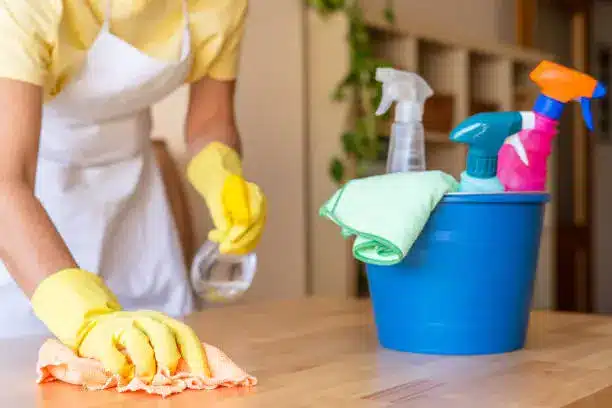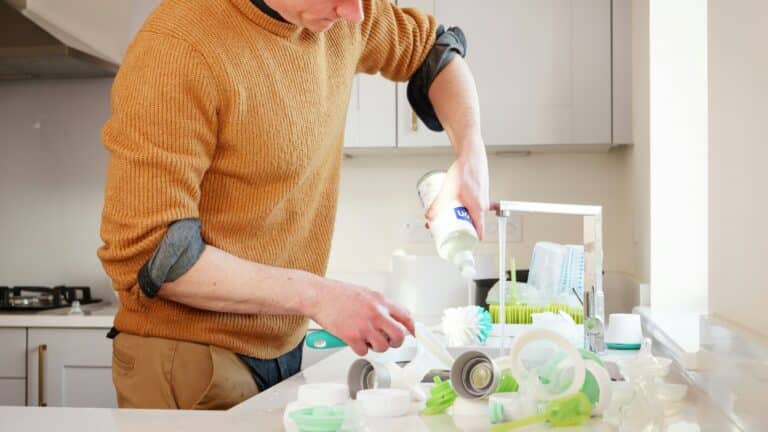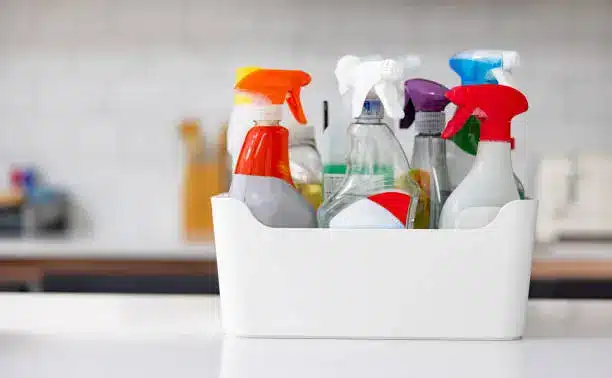As vital as these products are in keeping our homes safe, many store-bought disinfectants are chemically laden, posing potential threats to our health and environment. Wouldn’t it be remarkable if we could clean our homes effectively without exposing ourselves and the environment to such risks? That’s exactly what this article sets out to explore—cleaning green with powerful natural disinfectant recipes that actually work. 🌿🍋

Before you get skeptical about the effectiveness of natural disinfectants, it’s worth noting that they’ve been used for centuries, long before the advent of chemical cleansers. They’re made from ingredients you’d typically find in your kitchen or garden, and they can be as powerful, if not more, as their chemical counterparts when used correctly. And the best part? They’re safe, economical, and environmentally friendly, a win-win for you and the planet. 🌍
Over the course of this article, we’ll delve into some proven natural disinfectant recipes that you can whip up at home. We’ll take an in-depth look into the science behind why they work, to give you a thorough understanding of how to use them effectively. You’ll also discover a variety of practical applications for these disinfectants, ensuring you make the most out of your new cleaning routine. But first, let’s take a step back to comprehend why we need to consider natural disinfectants in the first place.
Understanding the Impact of Chemical Disinfectants
While many chemical disinfectants effectively eliminate germs, they often come with a hefty price. Many are associated with health hazards, ranging from skin irritation and respiratory problems to more serious implications like endocrine disruption and carcinogenicity. Additionally, they can harm the environment, contributing to pollution of our air and waterways. This revelation might be disconcerting, but fortunately, there’s a viable solution – making the shift to natural disinfectants. It’s a small step that can make a big difference. 😊
Power in Nature: Why Natural Disinfectants Work
Though it might seem like a modern trend, the truth is, our ancestors have relied on the power of nature to keep their surroundings clean and disease-free. Substances like vinegar, salt, and citrus were often used for their cleaning and disinfectant properties. Now, backed by science, these humble ingredients are making a comeback. They work by altering the pH levels, disrupting the cellular functions of microbes, or denaturing proteins, effectively killing or inhibiting the growth of harmful pathogens. This section will shed more light on the scientific reasons that make natural disinfectants a powerful ally in our fight against dirt and germs.
Whether you’re a DIY enthusiast or someone just trying to adopt a healthier and more sustainable lifestyle, the forthcoming sections of this article will provide you with a comprehensive guide on making and using natural disinfectants. Get ready to give your home a safe, healthy, and green clean! 🌱
In conclusion, embarking on this journey of clean green is more than just adopting a new cleaning regime. It’s about safeguarding our health, protecting the environment, and embracing a more sustainable lifestyle. It’s time we harness the power of nature for a safer, healthier home and a greener planet. Let’s get started!
Discover the Power of Clean Green: Natural Disinfectant Recipes That Work Wonders
With the increasing emphasis on maintaining a clean and safe environment, more and more homeowners are turning to natural solutions. Enter Clean Green: a movement that leverages the power of natural ingredients to create potent disinfectants that keep your home safe and healthy. In this article, we will delve into some truly effective natural disinfectant recipes. But first, let’s understand why it’s beneficial to go the natural route.
Many commercially available disinfectants contain harsh chemicals. While they may be effective at killing germs, they can also lead to various health issues such as skin irritation, respiratory problems, and even hormonal disruption. On the other hand, natural disinfectants made from ingredients like vinegar, tea tree oil, and citrus peels are non-toxic and pose fewer health risks. They are also eco-friendly, cost-effective, and surprisingly powerful in their germ-killing capabilities.
To assist you in embracing this clean green lifestyle, we’ve compiled a selection of natural disinfectant recipes. These recipes are simple to prepare and require ingredients that you likely already have in your kitchen. Before we start, remember that while these natural disinfectants are effective, they are not meant to replace hand washing or other recommended measures to prevent the spread of diseases.
Unveiling the Magic of Vinegar: Your Natural Disinfectant Superhero
Vinegar, particularly white vinegar, is a staple in the world of natural cleaning solutions. Its acidic nature gives it the ability to break down dirt, grease, and grime. More importantly, it can kill a wide array of germs and bacteria, making it an excellent natural disinfectant.
Creating a vinegar-based disinfectant is incredibly straightforward. All you need is white vinegar and water. Simply mix equal parts of vinegar and water in a spray bottle, and your natural disinfectant is ready for action. Use it on hard surfaces, let it sit for a few minutes, then wipe clean. Do note, however, that vinegar can harm certain surfaces like marble and some types of wood, so make sure to test it on an inconspicuous area first.
For a more potent vinegar-based disinfectant, consider adding tea tree oil into the mix. Tea tree oil is known for its strong antibacterial and antifungal properties, enhancing the disinfecting power of the vinegar. Combine one cup of vinegar, one cup of water, and ten drops of tea tree oil, and you’ve got yourself a powerful, natural disinfectant.
Going Citrusy: The Wonders of Lemon as a Natural Disinfectant
Who doesn’t love the fresh, invigorating scent of citrus? Not only do lemons lend a pleasant aroma to your homemade cleaners, but they also possess strong antimicrobial properties. Citric acid, found abundantly in lemons, is particularly effective against many types of bacteria and viruses.
One easy way to harness the power of lemons for disinfection is by creating a lemon-vinegar solution. Fill a glass jar with lemon peels, cover them with white vinegar, and let the mixture sit for two weeks. After the waiting period, strain the liquid, mix it with an equal amount of water, and transfer the solution into a spray bottle. This lemon-infused vinegar disinfectant is effective and leaves a refreshing citrus scent behind.
If you’re interested in seeing how to make a lemon-vinegar disinfectant, check out this video from the “Clean My Space” YouTube channel: “DIY Citrus Vinegar Cleaner.” Please note that this video is for illustrative purposes and may not exactly match the recipe described above.
Tea Tree Power: Harnessing the Antimicrobial Properties of Tea Tree Oil
Tea tree oil, derived from the leaves of the Melaleuca Alternifolia plant native to Australia, is a well-known natural antimicrobial agent. Its powerful antibacterial, antiviral, and antifungal properties make it an excellent ingredient for homemade disinfectants.
Creating a tea tree oil disinfectant is as simple as mixing two cups of water with two teaspoons of tea tree oil. Shake it well, and voila, your disinfectant is ready to use. Remember to shake the bottle before each use, as the oil tends to separate from the water.
For a more comprehensive comparison of the effectiveness of these natural disinfectants, check out the table below. Each disinfectant is evaluated based on its germ-killing ability, ease of preparation, and cost-effectiveness.
| Disinfectant | Germ-Killing Ability | Ease of Preparation | Cost-Effectiveness |
|---|---|---|---|
| Vinegar | High | High | High |
| Lemon-Vinegar | Medium | Medium | High |
| Tea Tree Oil | High | Medium | Low |
With these natural disinfectant recipes in your arsenal, you’re well on your way to keeping your home clean, safe, and free from harsh chemicals. Remember, going ‘clean green’ is not just about making your own natural disinfectants. It’s about creating a healthy, sustainable lifestyle that is kind to both you and the environment.
Conclusion
In conclusion, this article has provided an in-depth analysis of our central theme, aiming to provide a comprehensive understanding of the subject matter. We’ve delved into the intricate dynamics of IT and engineering, explicating the complex concepts in a manner that’s easily comprehensible.
To recap, we began by exploring the fundamentals, offering a solid groundwork to build upon. We then advanced to discuss the crucial role that these principles play in the broader context of the field. Subsequently, the article progressed to examine the practical applications and implications of the discussed theories, presenting a multitude of real-world examples and case studies to illustrate the ideas clearly.
Throughout the article, we’ve underscored the importance of a nuanced understanding of the subject matter, demonstrating how it is instrumental in optimizing the efficiency and efficacy of processes in both IT and engineering. The article has also highlighted how the mastery of these principles can provide a competitive edge in a rapidly evolving technological landscape.
This article was designed not just to provide information but to stimulate thought and encourage a deeper exploration of the subject. I urge readers to reflect on the content, ponder its implications, and consider how it can be applied to their respective fields. The shared knowledge can be a powerful tool to drive innovation and progress. 💡
Please feel free to share your thoughts, questions, or experiences related to the subject in the comments section. 📝 Your input can be invaluable to other readers, providing different perspectives and sparking insightful discussions.
Do not hesitate to share this article with your colleagues or friends who might find it useful. Let’s foster a culture of knowledge-sharing and continuous learning. 🚀
For those interested in delving deeper into the subject, I’ve curated a list of resources that can be instrumental in your learning journey.
1. [The Institute of Electrical and Electronics Engineers](https://www.ieee.org/) 🌐
2. [The Association for Computing Machinery](https://www.acm.org/) 🌐
3. [MIT OpenCourseWare – Electrical Engineering and Computer Science](https://ocw.mit.edu/courses/electrical-engineering-and-computer-science/) 🌐
Remember, continuous learning and development are the keys to staying relevant in this rapidly evolving world.
Finally, thank you for taking the time to read this article. I hope that it was enlightening and valuable. I look forward to hearing from you and exploring more complex subjects together in future articles. Keep learning, keep innovating, and keep pushing the boundaries of what’s possible. 🔭
Remember to connect with me on LinkedIn for more updates and articles. 👋
[Continue Reading](#)



